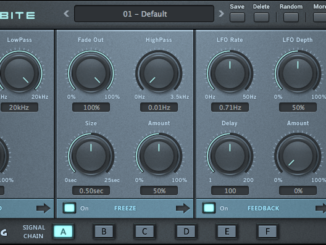Cherry Audio Atomika is a new Synthesizer plugin that emulates the iconic, rare, characterful FRF Polivoks from 1982; here is a full review and sound demo.
It’s not just American and Asian companies that have made Synthesizer history—for example, the Elka Synthex from Italy, which Arturia released as an emulation yesterday.
There were other “European” Synthesizer classics. One of the most characterful and bizarre of the time was the Polivoks from Formanta Radio Factory, which was marketed in the Soviet Union between 1982 and 1990. This unique synth from 1982 is now available as an emulation from Cherry Audio called Atomika.
Cherry Audio kindly gave me a version to test in advance. Thanks a lot. Before I delve into the Atomika, let’s go back in time and look at the Polivoks Synthesizer.
Formanta Radio Factory Polivoks
The original Polivoks was a duophonic, analog Synthesizer with two oscillators with FM, a filter, two envelopes, LFO, and a keyboard. Vladimir Kuzmin developed it and was marketed by Formanta Radio Factory between 1982 and 1990 in the former Soviet Union.
It is arguably the most popular and well-known Soviet Synthesizer in the West due to its unique appearance and sound. The first is due to its lettering, which is entirely in Cyrillic script that can be found on a very industrial-looking instrument. The look gives the impression that it is being built in the same factory as tanks.
Evil, aggressive, screaming, wild, industrial, and different—that’s what comes to mind when I think of the Polivoks Synthesizer. Cherry Audio wants to bring this unpredictable, growling character to your DAW in its new emulation.
First, and this is an important note: I will not discuss how authentic or close Atomika’s sound is compared to the original Polivoks Synthesizer. I don’t have the original device in the studio to compare it with the plugin.
I also never had the opportunity to spend a more extended period with the Polivoks. Hainbach has an excellent video about the Polivoks that gives you an idea of what is possible.
Cherry Audio Atomika Review
Atomika emulates the Formanta Radio Factory Polivok from 1981. According to Cherry Audio, Mark Barton, who was also responsible for other CA plugins, wrote the code.
Atomika offers 95% of the features of the original vintage Synthesizer: two oscillators with FM, noise, filter, two envelopes, and LFO with S&H. 95% because the external input function of the hardware was unfortunately not implemented.
Cherry Audio does not ship the plugin as an additional FX plugin, which allows you to route external audio through the characterful filter. That would have been fun.
However, the developers did not stick with the original features and added new features that made the synth more modern.
On the GUI side, Cherry Audio has opted for a design that is very similar to the original. You’d think you were looking at a Polivoks if you didn’t know. But it’s the Atomika.
It’s very advantageous. They decided against the original Cyrillic letters, so you can read the features. So, I can put my dictionary on its side. Like all other Cherry plugins, it offers smooth GUI scaling, undo/redo, and the focus function to zoom in on specific interface regions.
Let’s start at the top with the oscillators, the central element that generates the sound.
Oscillators
Atomika has two identical multi-wave oscillators (triangle, saw, square, and two different pulse settings) with footages ranging from 32′ – 2′, built-in hard-wired LFO modulation, OSC II FM on OSC1, and detune on OSC2.
I think the developers have done a great job of making the oscillators sound as unique as the Polivoks. A big part of the original’s sound was its unstable oscillators that drifted in/out of tuning. Not as much as the original, but a little to achieve the “living” vibe in Atomika.
You can always infuse the LFO modulation in each oscillator if you want more wobbliness. The frequency modulation (PWM) also does what you would expect. It is clean but has its own slightly nuanced character. It’s audible in many patches.
The mixer is located under the two oscillators. Both can be mixed, and additional noise can be added to the signal if required. Unlike the original, the external input knob is missing here. From here, it goes straight into the filter.
Characterful Filter
Much of the Polivoks’ brutal, gnarly, aggressive sound comes from the filter, which the developers have modeled and expanded. It was based on a “programmable op-amp” instead of a classic OTA.
Where the original only had lowpass and bandpass topology, Cherry Audio Atomika offers a highpass, notch, and peak on top of that. You can control the filter manually with various controls, including cutoff, resonance, keyboard tracking, starve, and filter drive.
You can also modulate the filter with the built-in LFO or the dedicated ADSR envelope with depth control. Plus, it has two envelope modes (standard or loop), giving you a second LFO on the main plugin panel and the original hardware.
To make Polivok’s unique filter character stand out even more, the developers have added two functions based on a few eccentric circuit behaviors that enhance it in wild fields. This was made in the form of the Starve and Filter Drive controls that add more of this distorted, gnarly goodness.
CA doesn’t tell us exactly what the Starve function does, but one thing is certain: it makes the filter scream like a child from hell. Add noise to the mix, dial in starve, and filter drive, and the filter screams beautifully musically.
Without these spicy ingredients, the filter can also be gentler without the urge to travel to hell. Then you have a filter with light saturation and still much character. With high resonance, you are again quick in wilder regions.
The three additional filter types (HP, Notch, Peak) are not authentic and original but bring much more versatility to the beautiful, evil Polivoks character. For me, it’s an excellent add-on that levels up the whole thing.
This filter as an external FX plugin would also have been a lot of fun. Hope Cherry Audio reads this and delivers it as a free update.
Modulation & VCA
From here, the signal goes into the VCA, contributing significantly to the Ambika crunchy character. Besides an ADSR envelope with a loop, you find an amp drive that heats and spices up your signal once more.
I have rarely had a Synthesizer plugin that clipped so quickly. A tip: always set the volume between 2-3 and you’ll be in the green zone; anything above that gets dangerously loud and hot.
A look at the left side where more original modulation can be found. You can work here with a simple LFO with expanded waveform selection with sync, key reset and mod-wheel assignment.
With a maximum of 20Hz, the LFO also goes nicely high, allowing you to create noisy modulation matching the character of the synth. Below, you can also activate the new unison function with an unison detune. I highly recommend using it. The sounds that come out with activated unison are pretty epic.
Next, you can dial in, glide in two variations, and set the voice. Atomika works in the original mono/duo configuration but also with up to 16 voices.
A look at the left side where more original modulation can be found. You can work here with a simple LFO with expanded waveform selection with sync, key reset and mod-wheel assignment.
With a maximum of 20Hz, the LFO also goes nicely high, allowing you to create noisy modulation matching the character of the synth. Below, you can also activate the new unison function with an unison detune. I highly recommend using it. The sounds that come out with activated unison are pretty epic.
Next, you can dial in, glide in two variations, and set the voice. Atomika works in the original mono/duo configuration but also with up to 16 voices.
Arpeggiator & Multi-FX
There is also a second view. By pressing the red button at the top right, you can access the built-in arpeggiator multi-FX processor. The built-in arpeggiator is classic and has basic features: four play directions, speed control, sync, and a 4-octave range.
Next to it is the multi-FX processor. Here, Cherry Audio relies on its all-time classics, which they also have incorporated into many other plugins. It includes a phaser, flanger/chorus, multi-type delay/echo (digital, tape, ping-pong), and multi-type reverb (spring, plate, room, hall, galactic).
There’s not much to say here. The effects are high quality and do what they’re supposed to. They can simply refine sounds, but they can also massively color them. I miss a global FX off. I would have liked to have had this on the main page when exploring the presets, as many are full of effects.
As a lovely sound design extra, Cherry Audio has given the Atomika Multi-FX section a dedicated multi-wave FX LFO that can be routed to the individual effects.
Sound Demo
Cherry Audio Atomika comes with over 350 presets, which are very impressive. They cover a wide sound field for many different genres. There is a bit of everything, from classic bass and leads to apocalyptic, industrial, and end-of-life soundscapes/drones. They are all sorted nicely in the preset browser.
The sounds are a lot of fun and inspiring. However, I would have liked to have sounds that didn’t have any effects in the signal to experience more of the synth’s rough sound. To give you an impression of what Atomika sounds like, I recorded a big sound demo with some feature details
Cherry Audio Atomika Review Summary
All in all, this is a very successful new Cherry Audio Synthesizer. It is one of my favorites so far, especially because of its brutal and assertive sound. I dig the modeled Polivoks filter, which is super fun and allows for many wild, dirty sonic adventures.
As I said, I don’t state how close Atomika is to the original Polivoks. But from my test, I got Polivoks vibes. On the one hand, through the oscillators that drift a bit and the characterful filter that breaks up the sounds meaningfully.
There is also criticism. I miss the filter FX version of Atomika and a global FX on/off button for the multi-FX section. Further, the modulation is too simple and vintage-inspired for my taste.
Pro
- sound quality
- rough, aggressive character and full of juice (“evil synth”)
- built-in FX
- polyphony
- price
Neutral
- 100% authentic yes/no?
- limited modulation with no mod matrix
Contra
- no global FX
- no filter FX plugin that emulates the external input feature of the original
Cherry Audio Atomika is available now for $49. It runs as a VST, VST3, AU, and AAX plugin and in standalone formats on macOS (native Apple Silicon + Intel) and Windows. The Cherry Audio website offers a free 30-day demo.
The Chain Reaction preset library with 100 new patches for Atmonika by sound designers James Dyson is available now for $9,99.
More information here: Cherry Audio











Always rated Cherry Audio. Great quality emulations at very reasonable prices.
Thanks for the detailed write-up, Tom. And for noting the missing external input!
I agree with you in noticing too many demos and presets use FX, instead of just letting us evaluate / enjoy the pure sound.
Have a good weekend!
Surprised at how individual it sounds.